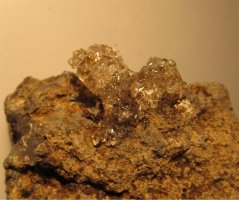Hyalite - glassy opal
› Detail › Hyalite - glassy opalExhibit of the month 10 / 2019
Hyalite - glassy opal
Hyalite is a variety of the mineral opal and its chemical composition is SiO2.nH2O. It is most often colorless, clear, and transparent. It has a greasy glassy luster and is therefore also referred to as "glassy opal." It most commonly forms through precipitation from hot solutions saturated with silicates during low-temperature hydrothermal processes, which has a fundamental influence on the shapes of the resulting minerals, which are spherical, grape-like, stalactitic, or kidney-shaped.
It can also fill cracks and cavities. The most famous deposit of hyalite for many years was Valeč on the edge of the Doupovské mountains in the Karlovy Vary region. Other Czech deposits of lower quality specimens include Vícenice in the Třebíč district, Křemže in the Český Krumlov district, and rare occurrences have also been described from locations in the Czech Central Highlands (Mojžíř, Radešín, Žežice). Worldwide, there are hundreds of deposits on all continents, but only a few of them match the quality of finds from the vicinity of Valeč.
Beautiful hyalites have been found, for example, in Mexico, Germany, Ethiopia, Australia, and in recent years also at several locations in Hungary. Hyalite has no industrial use. A small portion is used in its unprocessed state in jewelry making.
Fig 1 – Hyalite, Valeč, Karlovy Vary district, typical shape of hyalite from Valeč, next to hyalite are small white crystals of the mineral carbonate-fluorapatite





